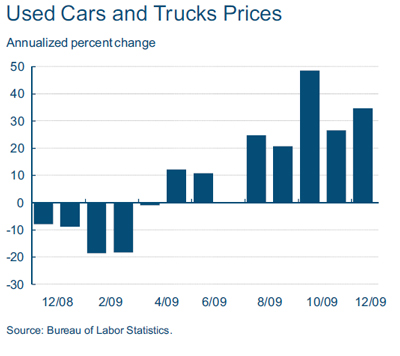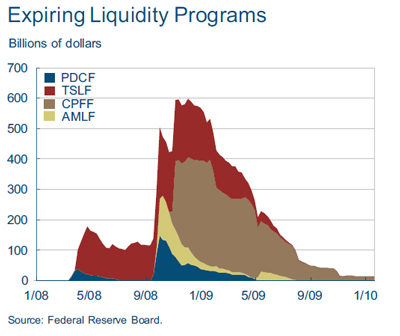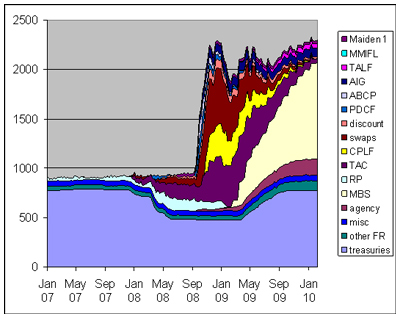The municipal bond insurance business looks sick:
Ambac Financial Group Inc., the second biggest bond insurer, faces as much as $1.2 billion in claims if a judge in Nevada allows Las Vegas Monorail Co., which runs a train connecting the city’s casinos, to reorganize in Chapter 11 bankruptcy. The City Council of Pennsylvania’s state capital shelved a plan to sell taxpayer-owned assets to meet payments on $288 million of debt used for an incinerator funded in part with bonds insured by a unit of Bermuda-based Assured Guaranty Ltd. Harrisburg is weighing a possible bankruptcy filing.
…
Last year, 183 tax-exempt issuers defaulted on $6.35 billion of securities, according to Miami Lakes, Florida-based Distressed Debt Securities Newsletter. That’s up from 2008, when 162 municipal borrowers failed to meet obligations on $8.15 billion of debt. In 2007, 31 of them defaulted on $348 million of bonds.
The timing of the UK Government disposition of its shares in banks is becoming a political issue:
David Cameron’s opposition Conservatives pledged to sell U.K. government stakes in Royal Bank of Scotland Group Plc and Lloyds Banking Group Plc to voters as their support continued to slip in opinion polls.
The plan to sell shares at a discounted price, outlined by Conservative Treasury spokesman George Osborne, comes as voters move away from the party after it called for spending cuts to start this year to reduce the budget deficit. A poll by YouGov Plc in the Sunday Times newspaper showed the Conservative lead over Prime Minister Gordon Brown’s Labour Party at its narrowest since December 2008.
…
Business Secretary Peter Mandelson dismissed the proposal in an interview with BBC Television as a “silly little gimmick,” saying retail investors already can buy shares at a “knock-down price.”Chancellor of the Exchequer Alistair Darling says the government will only sell its stakes in the banks when the shares have recovered enough to make a profit for taxpayers. Neither party has committed itself to a timetable for disposal.
Mind you, the British government is run by a pack of schoolkids:
Staff working directly for U.K. Prime Minister Gordon Brown contacted a telephone helpline that offers advice for people who say they have been bullied in the workplace, the BBC reported, adding to reports that he mistreated staff.
Who’s more contemptible? I’ll say the guy who is so insecure that he wants crybabies on staff, myself.
It is with a heavy heart that I report that Judge Rakoff has reluctantly approved a revised BofA / SEC settlement:
Bank of America Corp., the largest U.S. bank, won court approval of a $150 million settlement with the Securities and Exchange Commission over alleged misstatements about the purchase of Merrill Lynch & Co.
U.S. District Judge Jed S. Rakoff in New York said today he “reluctantly” approved the settlement of two suits in which the agency accused the Charlotte, North Carolina-based bank of misleading investors following the announcement that it would acquire Merrill Lynch. He criticized the accord as “half-baked justice at best” and “inadequate and misguided,” while adding that the law compels him to defer to regulators seeking approval.
No admission of guilt, no proof of guilt, no arguments for, no arguments against, nobody’s losing their license, nobody’s barred from being directors or officers. Just another case of regulatory extortion, with so-called justice being administered by bureaucrates behind closed doors. I liked the first plan better.
Volume picked up somewhat on a rough day for the market in which PerpetualDiscounts lost 20bp and FixedResets were down 3bp. All of the gainers with noteworthy performances were various flavours of floating rate issue.
| HIMIPref™ Preferred Indices These values reflect the December 2008 revision of the HIMIPref™ Indices Values are provisional and are finalized monthly |
|||||||
| Index | Mean Current Yield (at bid) |
Median YTW |
Median Average Trading Value |
Median Mod Dur (YTW) |
Issues | Day’s Perf. | Index Value |
| Ratchet | 2.82 % | 3.07 % | 31,700 | 20.38 | 1 | 1.4177 % | 1,955.2 |
| FixedFloater | 5.41 % | 3.50 % | 42,729 | 19.58 | 1 | 0.4998 % | 2,923.6 |
| Floater | 1.97 % | 1.69 % | 43,732 | 23.33 | 4 | 1.1371 % | 2,336.6 |
| OpRet | 4.87 % | 1.13 % | 105,074 | 0.18 | 13 | -0.2083 % | 2,310.8 |
| SplitShare | 6.36 % | -3.95 % | 129,541 | 0.08 | 2 | -0.2187 % | 2,147.0 |
| Interest-Bearing | 0.00 % | 0.00 % | 0 | 0.00 | 0 | -0.2083 % | 2,113.0 |
| Perpetual-Premium | 5.76 % | 5.55 % | 82,332 | 5.90 | 7 | -0.0904 % | 1,898.3 |
| Perpetual-Discount | 5.86 % | 5.88 % | 169,619 | 14.06 | 69 | -0.1974 % | 1,803.4 |
| FixedReset | 5.41 % | 3.56 % | 309,834 | 3.75 | 42 | -0.0316 % | 2,187.3 |
| Performance Highlights | |||
| Issue | Index | Change | Notes |
| MFC.PR.C | Perpetual-Discount | -2.42 % | YTW SCENARIO Maturity Type : Limit Maturity Maturity Date : 2040-02-22 Maturity Price : 19.04 Evaluated at bid price : 19.04 Bid-YTW : 5.92 % |
| BAM.PR.O | OpRet | -1.61 % | YTW SCENARIO Maturity Type : Option Certainty Maturity Date : 2013-06-30 Maturity Price : 25.00 Evaluated at bid price : 25.60 Bid-YTW : 4.48 % |
| HSB.PR.C | Perpetual-Discount | -1.23 % | YTW SCENARIO Maturity Type : Limit Maturity Maturity Date : 2040-02-22 Maturity Price : 22.27 Evaluated at bid price : 22.42 Bid-YTW : 5.78 % |
| MFC.PR.B | Perpetual-Discount | -1.04 % | YTW SCENARIO Maturity Type : Limit Maturity Maturity Date : 2040-02-22 Maturity Price : 19.63 Evaluated at bid price : 19.63 Bid-YTW : 5.94 % |
| PWF.PR.F | Perpetual-Discount | -1.00 % | YTW SCENARIO Maturity Type : Limit Maturity Maturity Date : 2040-02-22 Maturity Price : 21.49 Evaluated at bid price : 21.78 Bid-YTW : 6.08 % |
| TRI.PR.B | Floater | 1.10 % | YTW SCENARIO Maturity Type : Limit Maturity Maturity Date : 2040-02-22 Maturity Price : 22.71 Evaluated at bid price : 23.00 Bid-YTW : 1.69 % |
| BAM.PR.B | Floater | 1.19 % | YTW SCENARIO Maturity Type : Limit Maturity Maturity Date : 2040-02-22 Maturity Price : 16.95 Evaluated at bid price : 16.95 Bid-YTW : 2.34 % |
| BAM.PR.E | Ratchet | 1.42 % | YTW SCENARIO Maturity Type : Limit Maturity Maturity Date : 2040-02-22 Maturity Price : 22.19 Evaluated at bid price : 20.03 Bid-YTW : 3.07 % |
| BAM.PR.K | Floater | 1.43 % | YTW SCENARIO Maturity Type : Limit Maturity Maturity Date : 2040-02-22 Maturity Price : 17.00 Evaluated at bid price : 17.00 Bid-YTW : 2.33 % |
| Volume Highlights | |||
| Issue | Index | Shares Traded |
Notes |
| ACO.PR.A | OpRet | 414,091 | Called for redemption. Nesbitt crossed 400,000 at 25.63. YTW SCENARIO Maturity Type : Call Maturity Date : 2010-03-24 Maturity Price : 25.50 Evaluated at bid price : 25.55 Bid-YTW : 1.94 % |
| RY.PR.T | FixedReset | 120,515 | RBC crossed blocks of 40,000 and 70,000, both at 27.88. YTW SCENARIO Maturity Type : Call Maturity Date : 2014-09-23 Maturity Price : 25.00 Evaluated at bid price : 27.88 Bid-YTW : 3.54 % |
| BMO.PR.J | Perpetual-Discount | 54,957 | TD crossed 10,000 at 20.35 and 19,300 at 20.36. YTW SCENARIO Maturity Type : Limit Maturity Maturity Date : 2040-02-22 Maturity Price : 20.35 Evaluated at bid price : 20.35 Bid-YTW : 5.57 % |
| TD.PR.G | FixedReset | 41,413 | TD crossed 31,000 at 27.92. YTW SCENARIO Maturity Type : Call Maturity Date : 2014-05-30 Maturity Price : 25.00 Evaluated at bid price : 27.89 Bid-YTW : 3.47 % |
| BNS.PR.L | Perpetual-Discount | 33,765 | YTW SCENARIO Maturity Type : Limit Maturity Maturity Date : 2040-02-22 Maturity Price : 20.15 Evaluated at bid price : 20.15 Bid-YTW : 5.65 % |
| MFC.PR.B | Perpetual-Discount | 28,734 | Nesbitt crossed 20,000 at 19.66. YTW SCENARIO Maturity Type : Limit Maturity Maturity Date : 2040-02-22 Maturity Price : 19.63 Evaluated at bid price : 19.63 Bid-YTW : 5.94 % |
| There were 39 other index-included issues trading in excess of 10,000 shares. | |||













































































































Moody's Slashes Bank Preferred Ratings
Monday, February 22nd, 2010Moody’s Investors Service has announced that it has:
By way of comparison, Moody’s does not rate MFC, rates SLF preferreds at Baa2 and does not rate GWO, IAG or ELF.
Related posts on PrefBlog are Moody’s Downgrades BMO Prefs 4 Notches to Baa1 and Moody’s May Massacre Hybrid Ratings.
Posted in Issue Comments | 1 Comment »